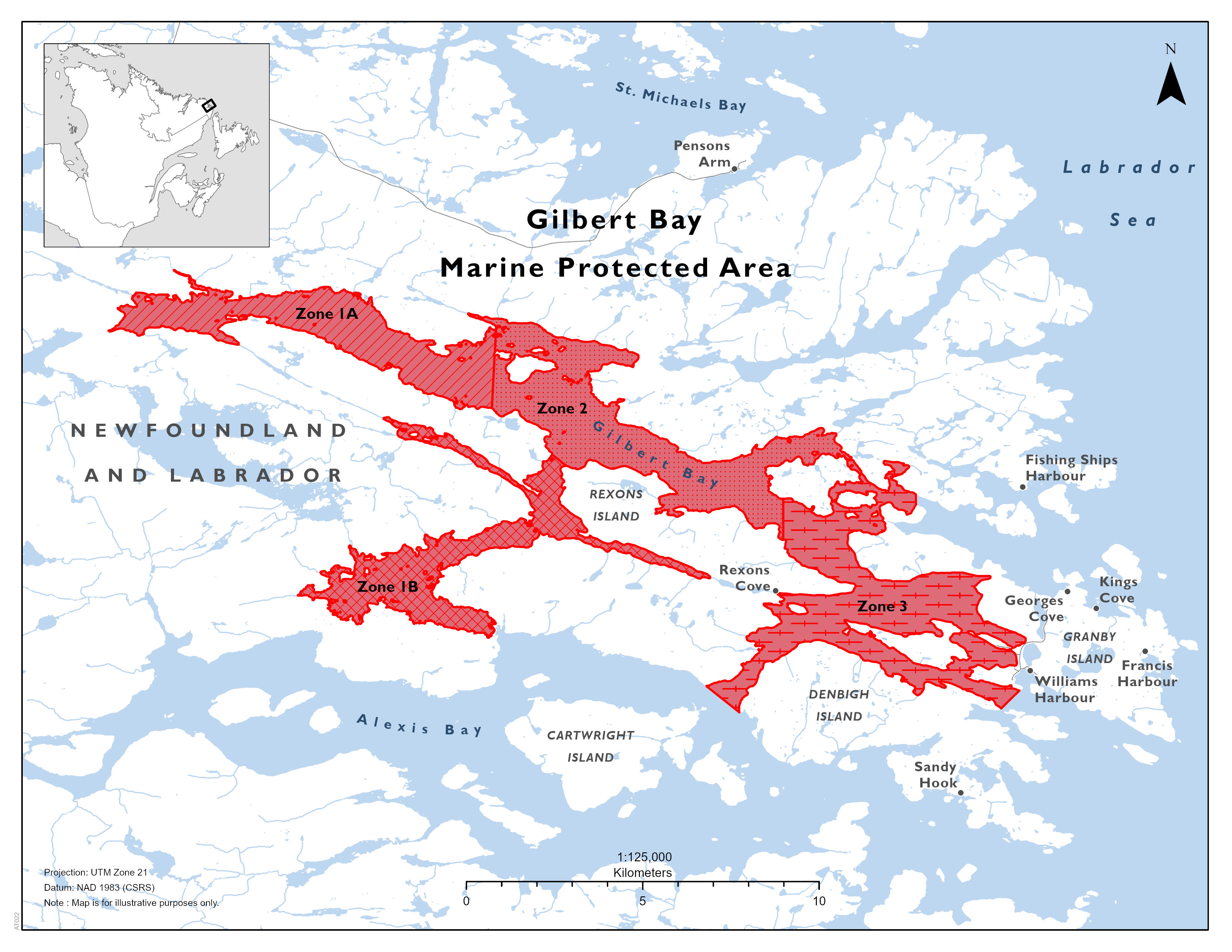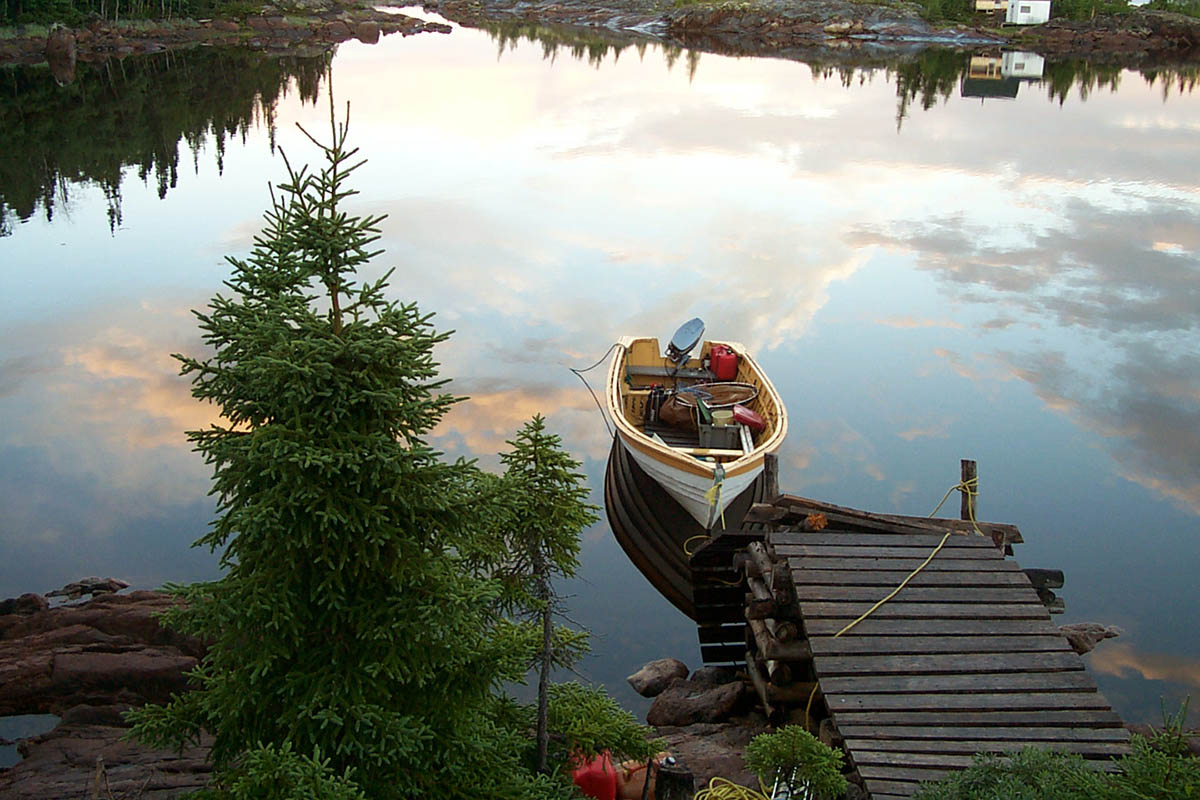Gilbert Bay Marine Protected Area (MPA)
Note:
Charts, diagrams and contact information on this website are provided for information purposes only and should not be used for fishing, navigation or other purposes. Please refer to the MPA Regulations or contact your regional Fisheries and Oceans Canada office for official coordinates.
On this page
At-a-glance

Map: Gilbert Bay Marine Protected Area
Dataset for all MPAs available.
Location
Southeast coast of Labrador; Newfoundland-Labrador Shelves Bioregion.
Size (km2) contribution to Marine Conservation Targets
About 60 km2
% coverage contribution to Marine Conservation Targets
About <0.01%
Date of designation
September 2005
Conservation objectives
- Conservation and protection of the Gilbert Bay cod and its habitats
- Conservation and protection of the Gilbert Bay ecosystem
- Facilitation of scientific research opportunities in the Gilbert Bay ecosystem
- Promotion of public awareness, education, and support of the Gilbert Bay MPA
Prohibitions
The Gilbert Bay MPA Regulations prohibit activities that disturb, damage, destroy or remove from this Area, living marine organisms or any part of their habitat, unless listed as exceptions in the Regulations or approved by the Minister.
Environmental context
The MPA provides long-term protection of the Gilbert Bay cod and its habitats. Gilbert Bay cod are a unique resident population of Atlantic cod, characterized by significant differences in the genetics, behavior, and physiology compared to other northern cod populations. The waters of Gilbert Bay also support a wide range of other marine species including shellfish, demersal and pelagic fish, and a wide variety of marine organisms and plants. The area is frequented by several species of waterfowl and marine mammals.
Ecosystem
The Gilbert Bay MPA was designated in 2005 at the request of local stakeholders, to protect a genetically distinct resident population of golden cod in Gilbert Bay known as the Gilbert Bay cod. Scientists from Memorial University of Newfoundland (MUN) initially began studying the Gilbert Bay cod in 1996. By 1998, a collaborative monitoring program was established by MUN and DFO with assistance from the NunatuKavut Fisheries Guardians. It was initially thought that the Gilbert Bay cod carried out their entire life cycle inside the MPA, but long term monitoring results have now shown that large (commercial size) Gilbert Bay cod move out of the MPA into Alexis Bay during the summer (June-September) to feed, where they overlap with Northern cod and associated fisheries.
Genetic studies provide evidence that chromosomal differences between Gilbert Bay cod and Northern cod are associated with marked differences in behavior and physiology. Gilbert Bay cod:
- are localized (non-migratory)
- are uniquely adapted to tolerate local environmental conditions that potentially kill cod of other populations
- thrived in cold ocean in 1990s, while Northern cod declined
The waters of Gilbert Bay also support a wide range of marine resources including:
- sea urchins
- several species of shellfish (mussels, scallops, snails, shrimp)
- northern cod, pelagic fishes (herring, capelin, salmon, eels, smelt, Arctic char)
- aquatic plants (eel grass, kelp)
The area is also frequented by several species of marine mammals and waterfowl including black ducks, geese and mergansers.
Management and conservation
The results of the monitoring program have shown a steep decline in Gilbert Bay cod, particularly large (commercial sized) cod, since the reopening of the commercial and recreational Northern cod fisheries in 2006. Management strategies have focused on reducing fishing mortality of Gilbert Bay cod outside the MPA during the summer.
The impacts of climate change are also a concern. Gilbert Bay cod are adapted to thrive in cold (sub-zero) coastal waters that would deter other over-wintering species including Northern cod. Warming winter water temperatures may increase competition with and predation by other groundfish species.
Activity application for Gilbert Bay MPA
Scientific and educational activities are allowed in the Gilbert Bay MPA if a proponent submits an activity plan to the Department of Fisheries and Oceans (DFO) for Ministerial approval.
Visit Activity application for Gilbert Bay to learn more
Publications
- Gilbert Bay Marine Protected Area (MPA) annual report 2023
- Comparing demersal fish and large mobile decapod crustacean assemblages in nearshore marine habitats across a boreal–sub-Arctic gradient using baited cameras (2025, PDF, 1.9 MB)
- Field observations of the movements of locally adapted Atlantic cod (Gadus morhua) living in zero and sub-zero centigrade temperatures for half the year (2024)
- Acoustic telemetry and network analysis reveal seasonal spatial overlap between gadid species in a subarctic coastal marine protected area (2024)
- Comparison of lethal and non-lethal age-based growth estimation methodologies to assess an endemic bay population of Atlantic cod (Gadus morhua) (2022)
- Fishing for Atlantic cod (Gadus morhua) with pots and gillnets: A catch comparison study along the southeast coast of Labrador (2022)
- Is the protected Atlantic cod (Gadus morhua) population in Gilbert Bay, Labrador, nearing a tipping point? (2021)
- Gilbert Bay Marine Protected Area monitoring report (PDF, 1.1 MB, 2009)
- Review of the Gilbert Bay Marine Protected Area monitoring indicators, protocols and strategies, and an assessment of the Gilbert Bay cod population (CSAS SAR - 2010/027) (2010)
- Gilbert Bay Marine Protected Area regulations
- Regulatory Impact Analysis Statement (PDF, 2.2 MB, 2005)
- Assessment of Gilbert Bay's Marine Protected Area Indicator Monitoring (CSAS ResDocs - 2017/055)
- Adapting Monitoring Protocols and Strategies for the Gilbert Bay Marine Protected Area (CSAS SAR - 2017/021)
- Gilbert Bay: marine protected area management plan: 2013-2018
- Ancient chromosomal rearrangement associated with local adaptation of a postglacially colonized population of Atlantic Cod in the northwest Atlantic
- MPA regulations should incorporate adaptive management — The case of Gilbert Bay Labrador Atlantic cod (Gadus morhua)
- Temporal and spatial migration of Atlantic cod (Gadus morhua) inside and outside a marine protected area and evidence for the role of prior experience in homing
- Date modified:



